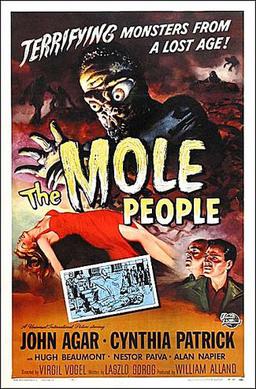It’s one of those movies that I know I’ve watched before—probably on a sleepy Saturday afternoon—but couldn’t believe I had already seen. While viewing The Mole People it looked completely new, but in retrospect some of it had seemed strangely familiar. Had I bothered to check my own blog I’d have noted that I watched it a mere fourteen years ago. Not that I’d have spared myself again. I felt like watching monsters in rubbery suits. Still, as I mentioned in my previous blog post on it, the antagonist are the underground Sumerians. These Sumerians speak English—a fact that isn’t worthy of remark by the scientists—and express surprise that outsiders can understand them. Assuming them to be gods because of their bright flashlight, this Gilliganesque story contains, perhaps unintended, social commentary. The mole people are really the good ones and the “slave revolt” at the end saves our protagonists.
For about the first half of the film they refer to “the goddess of Ishtar” before finally apparently realizing Ishtar is the goddess’s name. The “eye of Ishtar,” which looks suspiciously like a sideways Star Trek Federation logo, represents where the sun shines down on their ancient kingdom. (They’ve become albinos from living without sunlight.) The interesting thing here is that the monsters aren’t the scary part of the plot. The high priest is. Elinu is suspicious of the upper worlders immediately and it is he who plots their demise. He’s also quite willing to depose the king, whom he sees as too weak in his foreign policy. (In reality the interplay between religion and politics, historically, has been a tug-of-war over power.) He succumbs to his own plans, however, and the viewer is glad to see the priest go the way of all flesh.
Sometimes billed as science fiction, this is more fantasy horror fare. It’s literally swords and sandals among the the lackluster Sumerians. The monsters make it horror, but they aren’t evil, although they do kill one of the protagonists. To their credit these pre-Civil Rights Act Americans realize that the treatment of the eponymous mole people is unfair. There is, at the same time, no regret expressed that these scientists have brought the five-thousand-year-old Sumerian civilization to an end. The Mole People is one of those “so bad it’s good” movies. Its plodding pace doesn’t make it idea for too sleepy an afternoon, but the story is different than a typical monster flick from the era. And it is biblically based, as my previous post on it noted. And a lot has happened in the intervening fourteen years.

